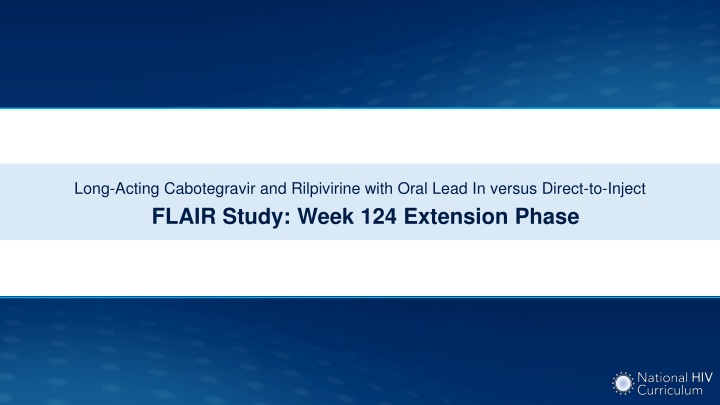
Long-Acting Cabotegravir and Rilpivirine Study at Week 124 Extension Phase
In the FLAIR Study's 124-week extension phase, the efficacy, safety, and tolerability of long-acting cabotegravir and rilpivirine with or without oral lead-in were compared. Results showed similar outcomes, supporting future evaluation of the direct-to-injection approach. Participants assigned to long-acting therapy demonstrated durable maintenance therapy with a favorable safety profile.
Download Presentation

Please find below an Image/Link to download the presentation.
The content on the website is provided AS IS for your information and personal use only. It may not be sold, licensed, or shared on other websites without obtaining consent from the author. If you encounter any issues during the download, it is possible that the publisher has removed the file from their server.
You are allowed to download the files provided on this website for personal or commercial use, subject to the condition that they are used lawfully. All files are the property of their respective owners.
The content on the website is provided AS IS for your information and personal use only. It may not be sold, licensed, or shared on other websites without obtaining consent from the author.
E N D
Presentation Transcript
Long-Acting Cabotegravir and Rilpivirine with Oral Lead In versus Direct-to-Inject FLAIR Study: Week 124 Extension Phase
Long-Acting IM CAB and IM RPV With or Without Oral Lead In FLAIR Study (124-Week Extension): Design Extension Phase Maintenance Phase Background: Extension of phase 3, randomized, open-label trial assessing IM CAB + IM RPV compared to DTG-ABC-3TC for treatment-na ve adults Week 100 Week 124 IM CAB + IM RPV every 4 weeks (n = 283) IM CAB + IM RPV every 4 weeks (n = 243) Inclusion Criteria: After 100-week maintenance phase, participants receiving IM CAB + IM RPV every 4 weeks could choose to continue (Continuation Group) or withdraw; those assigned to oral ART could choose to transition (Switch Group) to IM CAB + IM RPV after oral lead in or without oral lead in ( direct to inject ) n = 40 IM CAB + IM RPV After Oral Lead-In (n = 121) Oral DTG-ABC-3TC (n = 283) IM CAB + IM RPV Direct-to-Inject (n = 111) Oral lead in dosing: cabotegravir 30 mg daily and rilpivirine 25 mg daily x 4 weeks Loading injections: cabotegravir 600 mg IM and 900 mg rilpivirine IM x 1 Maintenance injections: cabotegravir 400 mg IM and 600 mg rilpivirine IM monthly Source: Orkin C, et al. Lancet HIV. 2021;8:e185-e196.
Long-Acting IM CAB and RPV With or Without Oral Lead In FLAIR Study (124-Week Extension): Results in Extension Phase Virologic Responses During 24-Week Extension Phase 100 HIV RNA <50 copies/mL (%) 99 93 93 80 60 40 20 227/243 113/121 110/111 0 CAB + RPV: Continuation CAB + RPV: Oral Lead-In CAB + RPV: Direct-to-Inject Continuation Group (IM CAB + IM RPV) Switch Group (prior DTG-ABC-3TC) Continuation group: randomized to IM CAB + IM RPV at baseline and at week 100 opted to continue IM CAB + IM RPV until week 124. Switch group: randomized to DTG-ABC-3TC and at week 100 switched to IM CAB + IM RPV with either oral lead in or direct-to-inject strategy Source: Orkin C, et al. Lancet HIV. 2021;8:e185-e196.
Long-Acting IM CAB and RPV With or Without Oral Lead In FLAIR Study (124-Week Extension): Conclusion Interpretation: After 24 weeks of follow-up, switching to long-acting treatment with or without an oral lead-in phase had similar safety, tolerability, and efficacy, supporting future evaluation of the simpler direct-to-injection approach. The week 124 results for participants randomly assigned originally to the long-acting therapy show long-acting cabotegravir plus rilpivirine remains a durable maintenance therapy with a favourable safety profile. Source: Orkin C, et al. Lancet HIV. 2021;8:e185-e196.
Acknowledgments The National HIV Curriculum is supported by the Health Resources and Services Administration (HRSA) of the U.S. Department of Health and Human Services (HHS) as part of an award totaling $1,000,000 with 0% financed with non-governmental sources. The contents are those of the author(s) and do not necessarily represent the official views of, nor an endorsement, by HRSA, HHS, or the U.S. Government. For more information, please visit HRSA.gov. This project is led by the University of Washington Infectious Diseases Education & Assessment (IDEA) Program.






















